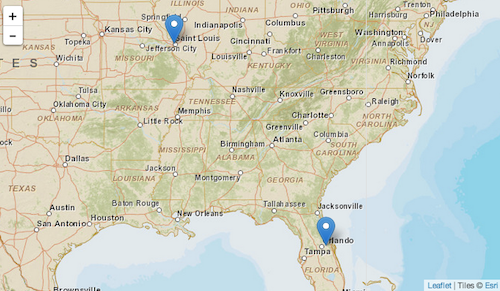
Mapping address data in Drupal can be confusing, if only because of the great number of contributed modules available that involve online maps. Picking the right module (or combination of modules) is challenging - especially for site builders who are new to mapping in Drupal. In this tutorial, we'll utilize the popular and well-supported Geofield module as one of the key ingredients in the common task of entering address data and having it displayed on an interactive map.
This tutorial contains step-by-step instructions for accomplishing this task, as well as a screencast demonstrating all of the steps.
We'll use the example of adding DrupalCamp address information to a Drupal 7 site. The site will then automatically display the DrupalCamp on a map on each camp's page, as well as display all camps on a single map. Finally, we're going to look at some of the options for using different map base layers.
This tutorial assumes that you're familiar with Drupal's "big 5" (content types, taxonomy, menus, users/roles/permissions, and blocks/regions/themes), the Views module, as well as downloading, installing, and enabling modules.
Here are the basic steps of what we'll be doing:
- Create a new DrupalCamp content type with a standard (postal) address field.
- Add a (Geofield) field to the DrupalCamp content type to store each address's corresponding latitude and longitude. The Geocoder module will be used to convert the postal address into latitude and longitude values.
- Configure the DrupalCamp content type so that a the latitude and longitude field are displayed as a map.
- Create a view that displays all DrupalCamp nodes' address information on a single map.
- Check out the various options for changing the look of the maps.
Screencast
Create a new "DrupalCamp" Content Type
We're going to use the Address Field module (which requires the Chaos tools module) to allow users to easliy input postal address information for each camp. Once the module is enabled, create a new "DrupalCamp" content type and add a new field of type "Postal address" (provided by the Address Field module). Give it a label of "Location", and set its configuration as follows (anything not listed can be left at default values):- Available countries: United States
- Format handlers: Address form (country-specific) and Name
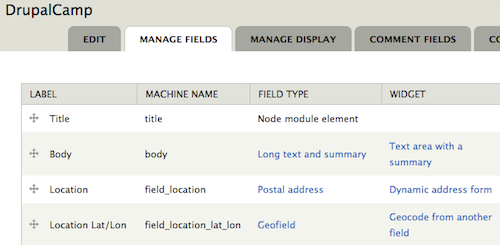
Provide a Field to Store Latitude and Longitude
The Geofield module is used to store geographic data in Drupal 7. It can store points, lines, and polygons, but for this example, we'll just be storing individual points (locations) - luckily, this is the easiest (and most common) scenario. The Geofield module also requires the Chaos tools module as well as the geoPHP module.The Geofield module also comes with the Geofield Map module, which we'll be using later in this tutorial.
Before we go ahead and add a new Geofield field type field to our DrupalCamp content type, we're going to want to go ahead and also enable the Geocoder module. This is because the Geocoder module provides a widget for the Geofield field type that we're going to use. The Geocoder module also requires the Chaos tools and geoPHP modules.
Now that we have all the required modules enabled, let's go ahead and add a new field to our DrupalCamp content type. Give it a label of "Location lat/lon", use a field type of "Geofield", and set its widget to "Geocode from another field" (this is where the Geocoder module comes in). Settings for the field are (anything not listed can be left at default values):
- Geocode from field: Location
- Geocoder: Google Geocoder
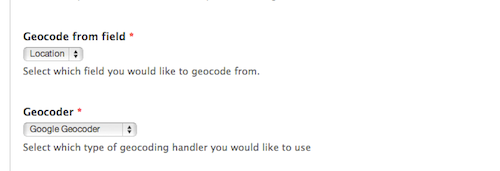
These two field settings are the key for automatically converting postal address data entered in the "Location" field into latitude/longitude data stored in the "Location lat/lon" field. The settings instruct the Geocoder module to grab the postal address data and send it to the Google Geocoder web service which does the heavy lifting of converting it to a latitude and longitude. Other geocoding services are available, but each one provides different capabilities and different usage limits. For Google Geocoder:
- Limit of 2,500 requests per 24 hour period - additional requests are available at various price points.
- Works for most countries
Feel free to add other fields to the DrupalCamp content type at your lesiure, but for this tutorial, this is all that we're going to need.
Display a Map for Each DrupalCamp Node
At this point, we're ready to add some DrupalCamp nodes. Find some DrupalCamps to enter - be sure to enter complete location information for each.You'll notice that as each one is added the "Location lat/lon" field displays something like "POINT (-90.3288385 38.6491536)". Navigate on over to the "Manage Display" settings for the DrupalCamp content type and notice that the formatter for the field is set to "Well Known Text (WKT)". According to Wikipedia:
Well Known Text (WKT) is a text markup language for representing vector geometry objects on a map, spatial reference systems of spatial objects and transformations between spatial reference systems.
While useful, it doesn't really provide site visitors with what they're looking for. By enabling the Geofield Map module (which comes with Geofield), we can now utilize the "Geofield Map" formatter on the "Location lat/lon" field (via the "Manage Display" page of our DrupalCamp content type). Select this, then set the formatter's settings as follows (anything not listed can be left at default values):
- Zoom: 15
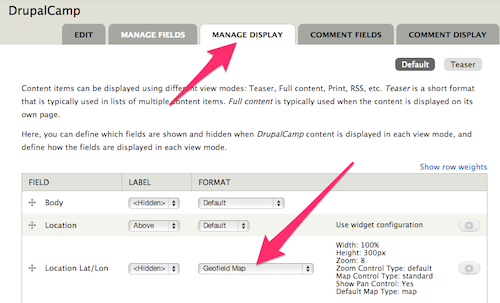
Now, go back and take a look at one of your DrupalCamp nodes; instead of the Well Known Text data, you should see a Google Map with a pin at the location of the DrupalCamp. Note that this is a fully-enabled Google Map that you can pan, zoom, and do most anything else you do with any other Google Map.
Note: you'll need to have an active internet connection for the map to display.
View All DrupalCamps on a Single Map
The ability to view numerous DrupalCamps on a single map is the next logical step. The Views module provides the ability to display lists of content. In this case, our content is DrupalCamp, and instead of a traditional "list", we're going to output our view as a map.Let's create a new view called "All DrupalCamps". Give it a single page display with a path of "all-drupalcamps" and filter it by:
- Content: Published = Yes
- Content: Type = DrupalCamp
- Content: Title
- Content: Location lat/lon
We want to be sure that we display all the DrupalCamp nodes on a single map, so modify the Pager settings as well:
- Pager: Display all items
- Data Source: Location lat/lon
- Popup Text: title
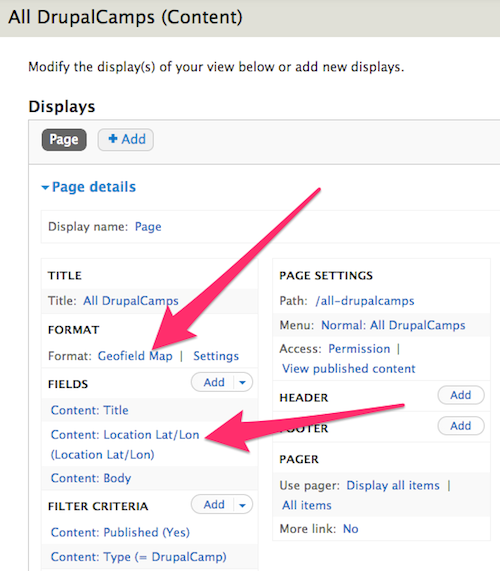
Navigate to the "all-drupalcamps" page on your site and you should see a Google Map with a pin displayed for each DrupalCamp node on your site.
Alternative Map Styles
While the Geofield Map module outputs only Google Maps, the Leaflet module provides a number of alternative "base layers" that can give your map various looks. While the Leaflet module does a lot more than just provide alternate base layers, we'll only be looking at this functionality in this tutorial.The Leaflet module requires the Libraries module, the Entity API module, as well as the 3rd-party Leaflet JS library. Be sure to read the installation instructions to make sure everything is installed properly.
The Leaflet module comes with several modules. For this tutorial, we'll need to enable the "Leaflet", "Leaflet More Maps", and "Leaflet views". modules.
Once everything is enabled, navigate back to the edit page for the "All DrupalCamps" view. Click to change the Format from "Geofield Map" to "Leaflet Map". Set the format settings as follows (anything not listed can be left at default values):
- Data Source: Content: Location lat/lon
- Title Field: Content: Title
- Map: pick one!
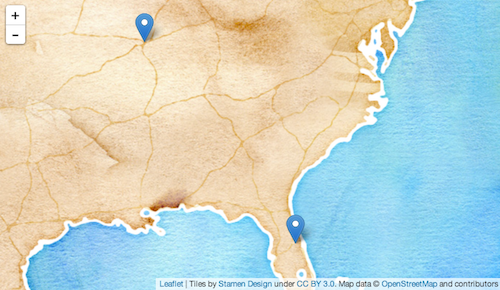
The "Map" setting provides numerous different options for various base layers for your map. Depending on the type of content and/or the style of the site, one base layer may be more appropriate than another. There are a good number of other options in the "Leaflet Map" settings, including the ability to use custom "points" (or "pins") and vector display options (for when the map is displaying more than just points). There's also a "Descriptive Content" field that can be used to display additional content about the DrupalCamp when the pin is clicked. This is commonly populated with a trimmed version of the body field of the node.
No comments:
Post a Comment
Thanks for your comment.